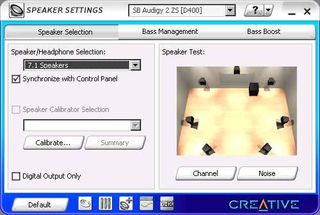DTS and 7.1: Creative Audigy 2 Platinum Pro
From Dolby Digital To DTS ES: What Surround Sound?
If we try and quickly summarize the development of multichannel sound, which is indispensable today, you must remember that the first attempts to produce Surround Sound in the movie theater dates back to the 1950s. The process was extremely expensive in those days, using magnetic movie sound tracks, especially on 70 mm film. In the mid-1970s, Dolby introduced a system based on two optical sound tracks. Although it was called Dolby Stereo, it wasn't a twin-channel but a four-channel system (right, center, left, surround) achieved from two tracks on which they were coded. The encoding, entitled MP Matrix (MP for Motion Picture) was given various names, but mainly Dolby Stereo or Dolby Surround. If the designers of Dolby Stereo were restricted to two sound tracks, that's because there was so little space available on 35 mm films. The reduction in the width of tracks in order to increase their number resulted in insoluble problems, but home applications began to be developed with Dolby Surround (three channels), and then Dolby Surround Pro-Logic (four channels).
Switching To Digital
With the advent of digital recording, based on an encoding called AC-3, the number of available channels could finally be increased. The process, known as Dolby Digital, offers five channels, plus a subwoofer channel (5.1) and the performance is a great improvement on Dolby Stereo, in particular as regards bandwidth. Dolby Digital was introduced into movie theaters in 1992, and made its début in the home on LaserDisks in 1995, then on DVD in 1997. While Dolby reigned supreme in the movie theater, digitization enabled other processes to compete with it, including DTS (Digital Theater System). DTS was introduced with "Jurassic Park." It was still a 5.1 system, but the soundtrack compression ratio was lower than that of Dolby and it ran on different equipment. Hence the superior sound quality, at least in theory.
Moving On To 7.1
The known formats were then improved and upgraded to Dolby Digital EX and DTS ES which added a speaker in the rear center (so now there were three speakers in front and three at the back). In the case of Dolby, the process involved a matrix configuration similar to that of Dolby Pro-Logic in order to create a sixth channel. In the case of DTS, the six channel could either be separate or part of the matrix. Real DTS ES 6.1 is the Discrete, as opposed to the DTS ES Matrix. These two versions naturally used DTS ES decoders like the one on the Audigy 2 ZS. You can also reproduce 6.1 Dolby Digital EX or DTS ES sound in 7.1, you just have to add another rear sixth channel. This was originally introduced for the movies, so that the moviegoer could hear rear sound everywhere. The Audigy 2 ZS 7/1 sound reproduction in EX or ES is produced in the same way. Whatever the configuration, compatibility is assured by outputting in 5.1, which is the right way to do it.
Always at the cutting edge of technology, Dolby and DTS have produced "new" technologies that are nothing more than refinements of greater or lesser importance on the basic techniques. Dolby brought out Dolby Pro Logic II, DTS produced its Neo:6. In both cases, they were trying to achieve a better move between sources from two through five channels for outputting in 6.1 or 7.1 using modes suitable for music, movies, and even - in Dolby's case - games. It's funny that the functions of these new forms of "surround" sound can already be found in certain products that don't even claim to be using these standards! In any case, no doubt slightly intimidated by this sudden leap forward, Dolby has confidence in the intrinsic value of 5.1 sound... If you summarize the whole story, the basis of multichannel sound is 5.1 with a possible extension to 6.1and an inflation that would tend to popularize the 7.1. The advantages of the 7.1 lie basically in its practicality. It is easier to install two rear loudspeakers which could be located at the sides than one central rear speaker that is either badly positioned or in an awkward position. Even if it is something of a luxury in a domestic setting, this is the kind of equipment that is pretty standard in a movie theater. On the other hand, it would hard to claim that this is a major advance in the technology of multichannel sound.

Stay on the Cutting Edge
Join the experts who read Tom's Hardware for the inside track on enthusiast PC tech news — and have for over 25 years. We'll send breaking news and in-depth reviews of CPUs, GPUs, AI, maker hardware and more straight to your inbox.
Current page: From Dolby Digital To DTS ES: What Surround Sound?
Prev Page Software Better Organized!, Continued Next Page How About On Our Card?-
This rocks, I use it. but creative sucks. I have to use modified X-Fi drivers with modified XP software to get eberything to run, and the remote doesn't work at all. Found intelliremote, recommend it for this, or anything really, can customize the remote to control anything, not jst creative's playcentre thingy :-)Reply
Most Popular

